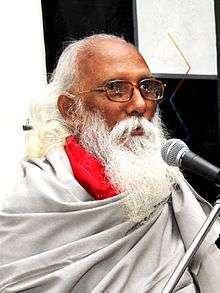Nirmalendu Goon
Nirmalendu Goon (born 21 June 1945)[1] is a Bangladeshi poet known for his accessible verse.[2] He was awarded Ekushey Padak in 2001 and Independence Day Award by the Government of Bangladesh in 2016.[3][4] He was also awarded Bangla Academy Literary Award in 1982.[2]
Nirmalendu Goon | |
|---|---|
নির্মলেন্দু গুণ | |
 Goon in Dhaka (2016) | |
| Born | 21 June 1945 |
| Nationality | Bangladeshi |
| Occupation | poet |
Early life and education
Goon was born in Kasban village, Barhatta Upazila, Netrokona District to Shukhendu Prakash Goon Chowdhury and Binaponi.[1] He passed the Matriculation examination in 1962 and Intermediate examination in 1964 from Netrokona College. In 1969, he earned his bachelor of arts degree. He published his poem Notun Kandari on the magazine Uttor Akash. On 21 February 1965, he published the poem Kono Ek Sangramir Drishtite on the magazine Weekly Janata.[1]
Poetry
Goon's first book of poetry, Premanghshur Rokto Chai, was published in 1970.[5] Since then he has published forty-five collections of poetry and twenty collections of prose. Part of the generation of poets of 1960s, Goon's poetry contains stinging criticism of the nouveau riche and a touching description of the contrasting fate of the masses. A love of freedom and faith in the human spirit also permeates many of his poems. An avowed Marxist, Goon has also written poems urging an upheaval of the poor against the rich. He also has written a number of poems on important personalities, including Rabindranath, Sheikh Mujibur Rahman, Lenin, Shakti Chattopadhyay and others.
Goon wrote three autobiographical books - Amar Chhelebela, Amar Konthhoshor and Atma Kotha 1971.[5]
The Library of Congress has a collection of thirty-seven titles by Goon.[2] Goon was among the five Bangladeshi poets who took part at the Gothenburg Book Fair '13 in Sweden with their publications.[6]
Selected works
- Premāṃśura rakta cāi (1970)
- Nā premika, nā biplabi (1972)
- Caitrera bhālobāsa (1975)
- Tāra āge cāi samājatantra (1979)
- Pr̥thibījoṛā gāna (1982)
- Dūra ha duḥśāsana (1983)
- Cirakālera bām̐śi (1986)
- Nirañjanera pr̥thibi (1986)
- Nirguṇera jārṇāla (1987)
- Nirmalendu Guṇera premera kabita (1987)
- Nirmalendu Guṇera rājanaitika kabitā (1989)
- Yakhana āmi bukera pān̐jara khule dān̐rāi (1989)
- Dhābamāna hariṇera dyuti (1992)
- Kābyasamagra (1992-1993)
- Gīnasabārgera saṅge (1994)
- Ānandaudyāna (1995)
- Pañcāśa sahasra barsha (1995)
- Priẏa nārī hārāno kabitā (1996)
- Gadyasamagra (1997)
- Raktajharā Nabhembara 1975 (1997)
- Śaktismr̥ti o anyānya (1997)
- Śiẏare Bāṃlādeśa (1998)
- Nāma diẏechi bhālobāsa (1998)
- Nirbācita (2000)
- Racanā 2000 (2001)
- Selected poems of Nirmalendu Goon (2001)
- Muthophone'r Kabbo (2003)
- Bhrami deśe deśe (2004)
- Atma Katha 1971 (2008)[8]
- Mujibmongol (2012)
- Cricket Shomogro (2012)[5]
Personal life
Goon has a daughter, Mrittika Goon.[1]
References
| Wikimedia Commons has media related to Nirmalendu Goon. |
- "সত্তর পেরিয়ে নির্মলেন্দু গুণ" [Nirmalendu Goon crosses 70] (in Bengali). banglanews24.com. 21 June 2014. Retrieved 18 January 2017.
- "Nirmalendu Goon, 1945". loc.gov. Retrieved 15 July 2012.
- "একুশে পদকপ্রাপ্ত সুধীবৃন্দ" (in Bengali). Government of Bangladesh. Retrieved 18 January 2017.
- "Goon named for Swadhinata Padak". The Daily Star. March 21, 2016. Retrieved January 18, 2017.
- "Ekush in conscience". The Daily Star. February 29, 2012. Retrieved January 18, 2017.
- "Five Bangladeshi poets shine in Sweden". The Daily Star. October 31, 2013. Retrieved January 18, 2017.
- "Nirmalendu Goon turns painter". The Daily Star. July 25, 2009. Retrieved January 18, 2017.
- Alam, Mohit (July 31, 2009). "Those days of dark, intense fear". Retrieved January 18, 2017.